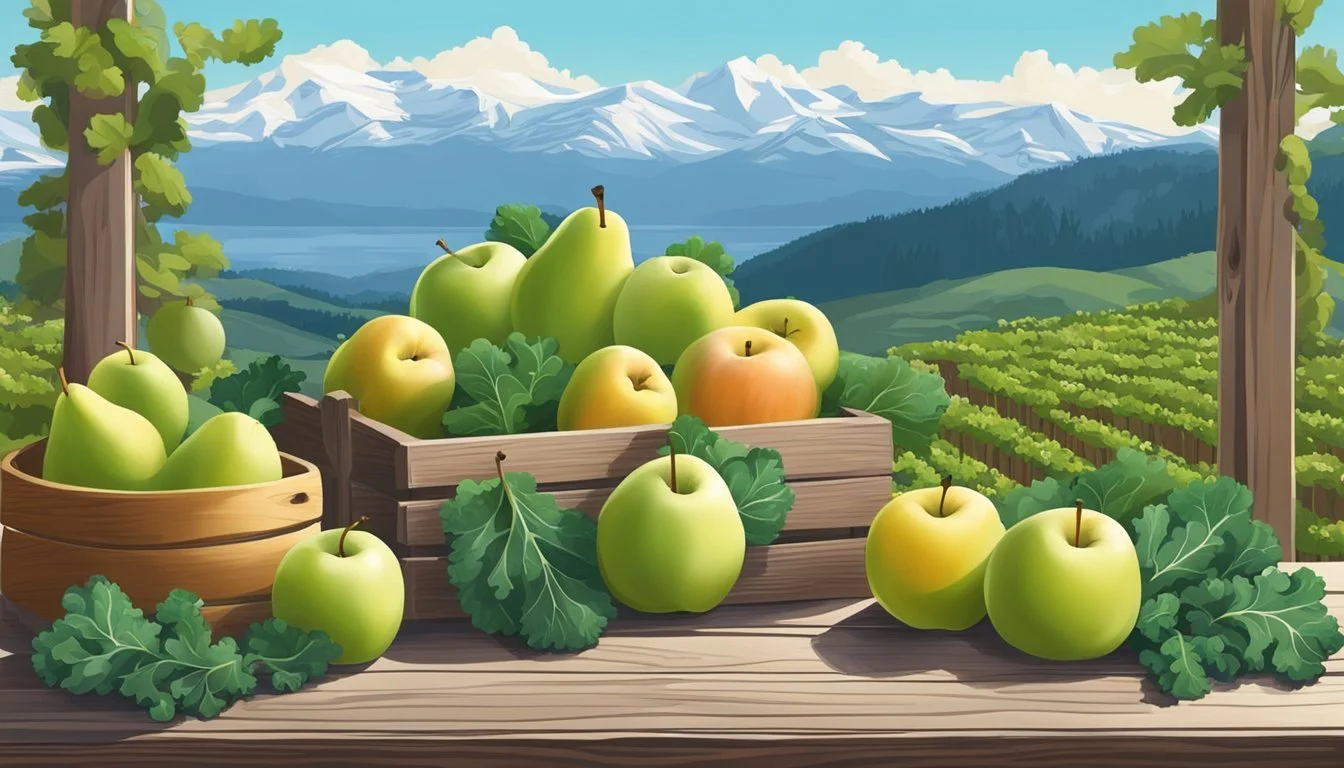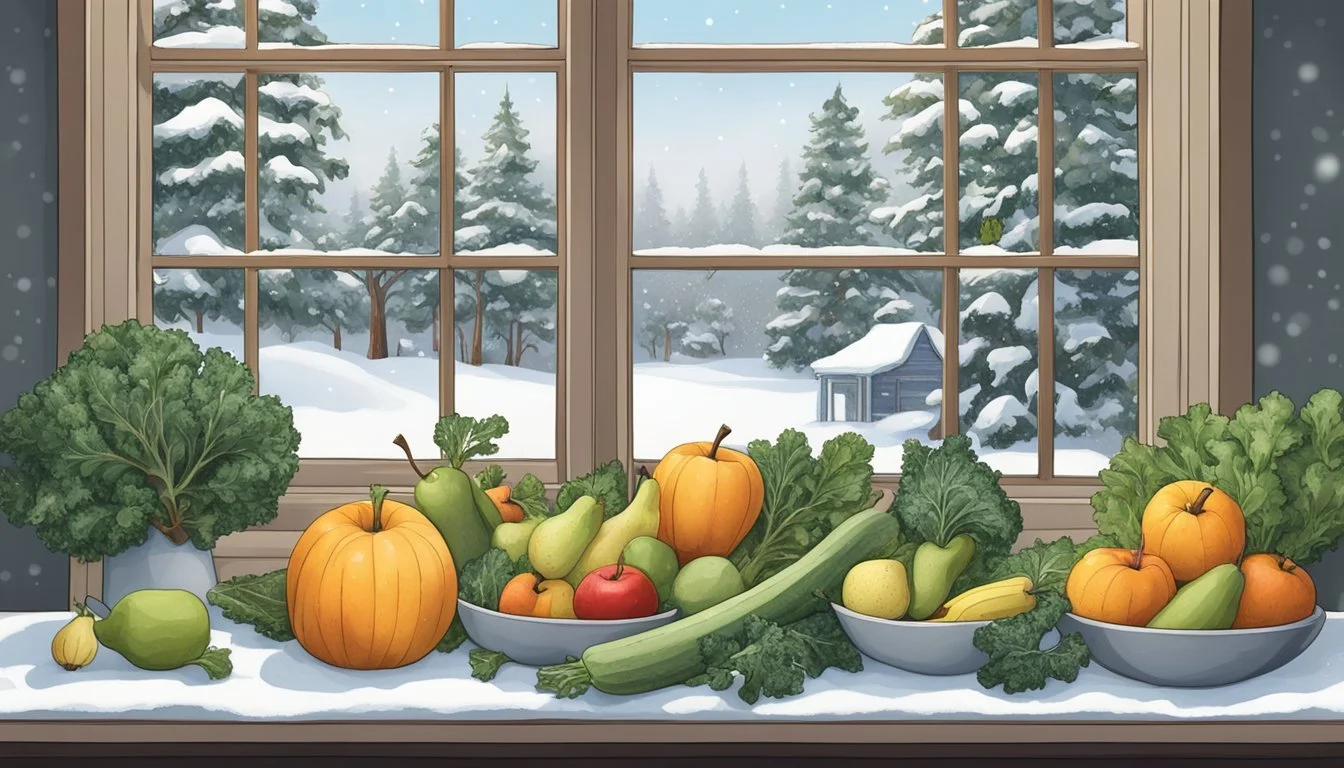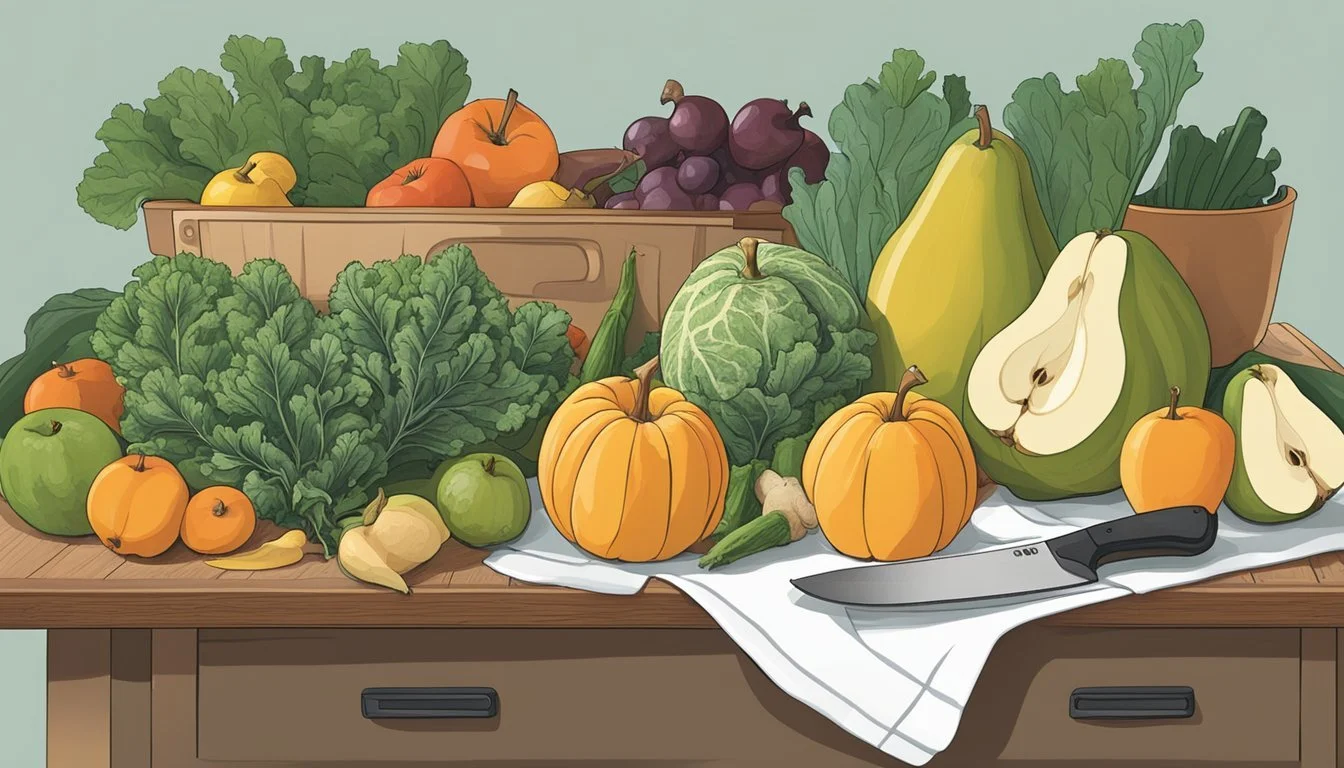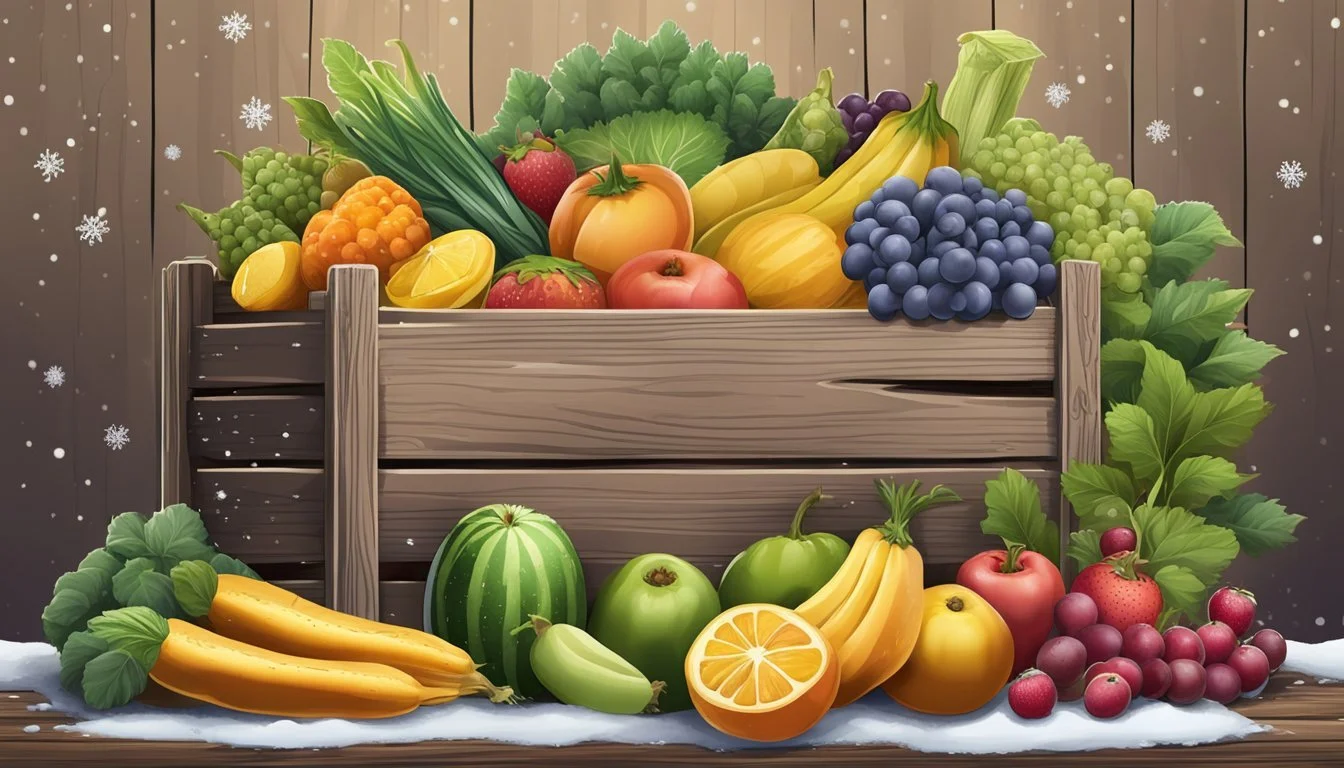Oregon Seasonal Fruit & Vegetables in January
Your Guide to Fresh Produce
This Article is Part of our Oregon Seasonal Fruit & Veg Calendar
January in Oregon presents a distinct array of seasonal produce that reflects the region's agricultural diversity and complements the cooler climate. Vegetables like beets, Brussels sprouts (how long do brussels sprouts last?), and various cabbages continue to thrive, offering robust flavors and nutritional benefits suited to winter meals. Root vegetables, such as carrots, remain in season as well, providing a sweet, earthy element to a variety of dishes.
The state’s fruit (What wine goes well with fruit?) selection during this time is more limited compared to the bountiful summer months, yet citrus fruits, often at their peak elsewhere, are commonly available in markets due to transportation from warmer climates. Local storage crops like apples and pears, harvested in the fall, are still accessible, maintaining Oregon’s commitment to providing fresh, locally-sourced produce throughout the colder months.
As consumers remain interested in locally-grown options, Oregon's January produce serves as a testament to the region's capacity to supply fresh and flavorful fruits and vegetables for winter cuisines. The state's farming industry continues to adapt and promote these seasonal offerings, encouraging a connection to the regional food system and a deeper appreciation for the seasonal rhythms of agriculture.
Understanding Oregon's Seasonal Produce
In January, Oregon's seasonal produce is shaped by its winter climate, offering a distinct selection for consumers focusing on flavor and health benefits. Understanding the seasonal rhythms and how they affect local agriculture is key to appreciating and making the most of Oregon's bountiful harvest.
Climatic Influence on Produce
Oregon's diverse climate, with its wet winters and warm summers, significantly impacts the types of produce available each season. In January, cooler temperatures and shorter days mean that hearty root vegetables and winter greens are typically in abundance.
January's Harvest Cycle
The harvest cycle in January leans heavily on cold-tolerant crops. What's in season includes:
Root vegetables: Carrots, beets, and turnips
Winter greens: Kale and chard
Squashes: Acorn and butternut squash (how long does butternut squash last?)
Benefits of Seasonal Eating
Consuming produce during its natural growing season can lead to better flavor and nutrition. Winter crops available in Oregon are often rich in vitamins and minerals necessary to support health during the colder months.
Navigating Seasonal Availability
Residents can find what's in season by visiting farmers markets or using online resources, such as state agricultural reports. Recipes during this time often feature soups and stews that highlight the robust flavors of January produce.
Sourcing and Buying Local
Supporting local farmers by purchasing Oregon produce ensures access to fresh ingredients and helps bolster the state's economy. Farmers markets and local groceries often offer a wide selection of January's seasonal produce.
Storage and Preservation
To maintain freshness, seasonal produce should be stored correctly. Root vegetables can be kept in cool, dark places, while winter greens are best refrigerated. Preservation methods like canning and freezing also extend the availability of seasonal flavors.
Agricultural Practices in Oregon
Oregon farmers utilize sustainable farming practices to maintain the health of their land. Rotating crops and employing integrated pest management are just two techniques that reflect the state's commitment to responsible agriculture.
Environmental Impact and Sustainability
Sustainable consumption of local produce can reduce carbon footprints by decreasing transportation. Eating seasonally and locally in Oregon supports a food system that's aligned with the state's environmental goals, promoting healthier ecosystems.
Seasonal Fruit Available in January
January in Oregon marks a period where certain fruits are at their peak of freshness. Enthusiasts of local produce will find that citrus fruits, traditional core fruits such as apples and pears, and even some subtropical varieties like kiwi are available.
Citrus Fruits
In Oregon, January is a time when citrus fruits are not typically abundant due to the colder climate, which is not conducive for growing citrus varieties. However, some stores may carry citrus fruits from other regions, including varieties such as oranges, lemons, and grapefruits, known for their vibrant flavor and richness in vitamin C.
Core Fruits
Apples: A staple in the Oregon produce scene, apples can be found in various types, each with its unique flavor profile. Apples remain crisp and fresh during this month.
Pears: Another core fruit that is available is the pear; with its sweet and buttery texture, it provides a delightful option for fruit lovers.
Berries and Subtropical Varieties
Kiwi: Even though January is not the prime season for berries in Oregon, kiwi, a subtropical variety, is often still available and provides a sweet and tangy flavor that is a favorite for many.
Oregon's fruit selection in January may not be as varied as in the warmer months, but the fruits mentioned above exhibit excellent quality and taste, making them wonderful choices for those looking to enjoy seasonal produce.
Seasonal Vegetables Available in January
In January, Oregon's farms provide a robust selection of hardy vegetables that can withstand the cool temperatures. Fresh, local produce available during this month includes an array of root vegetables, leafy greens, cruciferous vegetables, various squashes and gourds, alliums, and tubers.
Root Vegetables
Root vegetables thrive in Oregon's winter soil, offering a sweet, earthy flavor intensified by the colder weather. Key varieties include:
Carrots: Ideal for stews and roasts.
Parsnips: A paler cousin of the carrot with a sweeter taste.
Turnips and Rutabagas: Sturdy vegetables suitable for various dishes.
Beets: Known for their deep red color and sweet flavor profile.
Leafy Greens
Even in the chill of January, Oregon's hearty leafy greens are abundant, providing a fresh taste and a burst of nutrition:
Kale and Chard: Hardy greens that can survive frosty conditions.
Collard Greens (how long do collard greens last?): Often cooked in traditional Southern recipes.
Lettuce and Spinach: Perfect for winter salads.
Cruciferous Vegetables
Packed with nutrients, cruciferous vegetables are an essential part of the winter diet. These include:
Broccoli: A versatile vegetable that can be served in numerous ways.
Cauliflower: (how long does cauliflower last?) Offers a milder flavor and can be used as a low-carb alternative.
Brussels Sprouts: Small but flavorful, often roasted to enhance their taste.
Squashes and Gourds
Squashes and gourds are staple highlights of the winter season, with their warm flavors and comforting textures:
Winter Squash: Including varieties like acorn and butternut squash.
Pumpkins: Not just for pies, they can be used in savory dishes as well.
Alliums
Alliums are the flavor foundation for many warm dishes that are perfect for January weather:
Onions: A kitchen staple, integral to numerous recipes.
Leeks: Milder than onions and excellent in soups.
Garlic: Adds a robust flavor to any dish.
Tubers
Tubers are versatile and provide a comforting starch content for the winter months:
Potatoes: Incredibly versatile for mashing, roasting, or making soups.
Sweet Potatoes: A sweeter and more nutrient-rich option.
Preparation and Usage of January Produce
In January, Oregon's bounty offers a variety of fresh produce that can be utilized in numerous dishes and preservation methods. From robust greens to root vegetables, the preparation and usage of these items are essential for maximizing flavor and health benefits.
Cooking Techniques
Hearty greens like kale and cruciferous vegetables such as broccoli and cauliflower thrive in January's cool climate. These vegetables are well-suited for roasting, which enhances their natural sweetness, and for steaming, to maintain their nutritional value. Soups and stews are particularly fitting for the season, allowing the incorporation of root vegetables and seasonings like rosemary and thyme for added flavor.
Winter Salads and Sides
January greens such as kale can be massaged with a bit of olive oil to create tender, flavorful salads. Adding roasted root vegetables to salads provides a comforting warmth and complexity. Citrus, in season during January, offers a zesty brightness to winter salads. Sides of steamed broccoli or cauliflower can be enhanced with a sprinkle of sage or thyme.
Seasonings and Flavor Pairings
The earthy flavors (What wine goes well with earthy flavors?) of root vegetables pair well with bold herbs like rosemary, sage, and thyme. Citrus zest and juice can be used to bring a fresh, bright note to heavy winter dishes. These seasonings not only add layers of flavor but also contribute health benefits, such as improved digestion and anti-inflammatory properties.
Preservation Methods
To extend the enjoyment of January produce, preservation methods like canning, pickling, and freezing are effective. Root vegetables, when stored in a cool, dark place, can last several months. Greens can be blanched and frozen for future use. Herbs may be dried or frozen in olive oil to retain their flavor.
Healthy and Nutritious Recipes
January's harvest lends itself to recipes that are both healthy and nutritious. Cruciferous vegetables are rich in vitamins and can be incorporated into recipes like roasted vegetable medleys or pureed for a comforting soup. Leafy greens work well in salads and smoothies, providing fiber and essential nutrients. Utilizing the available produce in a variety of recipes ensures a diet that is rich in vitamins and minerals during the winter months.
Community and Cultural Aspects
January in Oregon reflects a community deeply intertwined with its local produce, where cultural elements are celebrated through food festivals, local movements, and educational outreach. These engagements not only honor Oregon’s agricultural diversity but also reinforce connections among farmers, consumers, and local traditions.
Food Festivals and Events
January marks a quieter season for Oregon's outdoor food festivals, but indoor events like cooking classes that focus on seasonal produce are prominent. These events are opportunities for community gathering, celebrating the richness of Oregon's winter bounty through culinary experiences. They often feature local chefs and serve as a showcase for winter crops like root vegetables and hearty greens.
Local Food Movements
Oregon's community-supported agriculture (CSA) programs gain significant traction in January. Residents invest in local farms, receiving shares of seasonally fresh food. This fosters community resilience and supports sustainable practices. Moreover, farmers' markets, such as the Oregon City Farmers Market, continue to connect consumers with local, seasonal produce even during the colder months.
Educational Opportunities
Winter in Oregon provides a unique chance for educational programs focusing on seasonal eating, preservation, and preparation of local produce. Workshops organized by agricultural cooperatives or local food groups offer insights into selecting and utilizing winter crops. Additionally, cooking classes held by local chefs or community centers enable participants to explore new recipes that highlight January's seasonal vegetables and fruits.
Conclusion
January in Oregon offers a variety of fresh produce that caters to healthy meal preparation and boosts immunity during the colder months. Consumers can indulge in hearty greens like kale, which is abundant during this time. Bringing color and nutrition to the table, citrus fruits such as oranges and lemons are also in season, ideal for vibrant dishes that can help fend off winter ailments.
Vegetables like broccoli, cauliflower, and romanesco are not only available but are versatile for a range of recipes. They pair well with the mentioned citrus for dishes that are as flavorful as they are nutritious. Oregon farmers work to ensure these winter crops are accessible, highlighting the state's dedication to sustainable and seasonal farming practices.
For those seeking the freshest produce, understanding what is in season is key. Utilizing the seasonal calendar supports local agriculture and ensures that the produce consumed is at its peak for flavor and nutrition. The selection available in January is just a glimpse of Oregon's rich agricultural landscape, which changes and offers new varieties with each passing month.
Supporting local farmers by choosing seasonal produce is a sustainable choice that benefits not only individual health but also the local economy and environment. As January's selection makes clear, Oregon's seasonal offerings provide ample opportunity for culinary exploration and healthful living.








